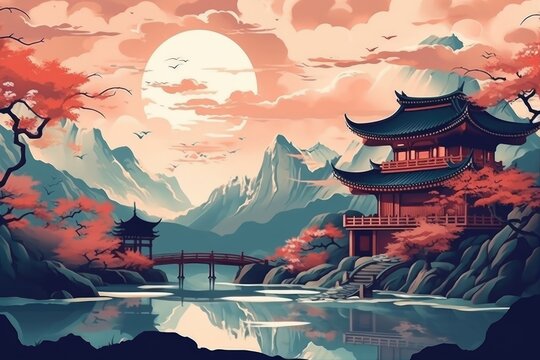
Chinese culture arts encompass a vast array of artistic expressions that have evolved over thousands of years, serving as a mirror reflecting the rich heritage, philosophical beliefs, and social values of one of the world’s oldest civilizations. From traditional painting and calligraphy to music, dance, and crafts, each form of artistic expression contributes to the broader narrative of Chinese identity. This exploration delves into the various dimensions of Chinese culture arts, tracing their historical roots, their significance in contemporary society, and their enduring influence on both domestic and global stages.
The origins of Chinese culture arts can be traced back to ancient times, where the interplay of spirituality, nature, and human experience shaped early artistic expression.
Ancient Traditions: The earliest forms of art in China can be found in pottery, jade carvings, and bronze artifacts from the Neolithic period. These items not only served practical purposes but also held spiritual significance, often used in rituals and ceremonies. The intricate designs and symbolism in these early works laid the foundation for the artistic traditions that would follow.
Calligraphy and Painting: The development of writing systems during the Shang Dynasty (circa 1600-1046 BCE) marked a pivotal moment in Chinese culture arts. Calligraphy, as both a practical means of communication and a revered art form, became central to Chinese identity. The brush strokes of calligraphy reflect the artist's personality and emotions, emphasizing the connection between writing and visual art.
Philosophical Influences: The philosophies of Confucianism, Daoism, and Buddhism have profoundly influenced Chinese culture arts. Confucian ideals emphasized harmony, order, and moral integrity, which are often reflected in the themes and subjects of traditional art. Daoism's reverence for nature inspired numerous landscape paintings, while Buddhism introduced new iconography and spiritual elements into Chinese art.
Dynastic Contributions: Each dynasty in Chinese history contributed uniquely to the evolution of culture arts. The Tang Dynasty (618-907 CE) is often regarded as a pinnacle of artistic achievement, characterized by flourishing poetry, painting, and calligraphy. The Song Dynasty (960-1279 CE) emphasized personal expression and innovation, leading to the development of new styles and techniques.
Chinese culture arts encompass a diverse range of forms, each with its unique characteristics and cultural significance.
Visual Arts:
Performing Arts:
Crafts and Decorative Arts:
Literature:
Chinese culture arts serve multiple purposes within society, from preserving history and values to fostering community and identity.
Cultural Preservation: The arts are a vital means of preserving cultural heritage and transmitting knowledge across generations. Traditional art forms encapsulate historical narratives, rituals, and customs, ensuring that the essence of Chinese culture endures amidst modernization.
Identity and Unity: Chinese culture arts foster a sense of identity and belonging among individuals and communities. They celebrate shared traditions and values, reinforcing cultural ties that unite people across diverse regions and backgrounds. Festivals, performances, and exhibitions bring communities together, creating a collective appreciation for cultural heritage.
Educational Value: The arts play an essential role in education, promoting creativity, critical thinking, and cultural awareness. Schools often incorporate traditional arts into their curricula, providing students with opportunities to engage with their heritage. Through the practice of calligraphy, painting, and music, young people learn about their cultural roots while developing artistic skills.
Social Commentary: Art has the power to reflect societal issues and provoke thought. Many contemporary Chinese artists use their work to address social, political, and environmental concerns, contributing to dialogues that challenge norms and inspire change. This intersection of art and social commentary highlights the dynamic relationship between culture and society.
The influence of Chinese culture arts extends beyond national borders, impacting the global artistic landscape.
Cultural Exchange: International exhibitions and cultural events promote the appreciation of Chinese arts worldwide. Artists from various backgrounds engage with traditional Chinese techniques, creating hybrid forms that enrich the global art scene. This cultural exchange fosters understanding and respect among diverse communities.
Art Market: The market for Chinese culture arts has grown significantly, with collectors and enthusiasts seeking authentic pieces that reflect cultural heritage. The demand for traditional and contemporary artworks has led to increased visibility for Chinese artists, allowing them to share their work on global platforms.
Inspiration for Artists: Chinese culture arts continue to inspire artists around the world, influencing styles, techniques, and themes. The aesthetics of Chinese painting, calligraphy, and design can be seen in contemporary art movements, highlighting the timeless appeal of these traditions.
Digital Platforms: The rise of digital technology has transformed the way Chinese culture arts are shared and experienced. Online galleries, social media platforms, and virtual exhibitions provide new avenues for artists to showcase their work and connect with global audiences. This digital landscape expands the reach and impact of Chinese arts, making them accessible to a wider audience.
Chinese culture arts represent a vibrant tapestry of artistic expression, reflecting the rich heritage and identity of China. From ancient traditions to contemporary innovations, the diverse forms of art encapsulate the values, beliefs, and experiences of its people. As we explore the significance of Chinese culture arts, we celebrate their enduring impact on society, culture, and the global artistic landscape.
By engaging with these artistic traditions, we not only honor the past but also foster a deeper understanding of the human experience, connecting us across time and space. The journey through Chinese culture arts is an invitation to appreciate the beauty and complexity of artistic expression, encouraging us to embrace the stories that shape our world.
| Price: | 48800 |
| Categories: | Items for Sale / Art & Crafts |
| Phone: | +92 332-8545246 |
| Address: | F9 |
| Email: | hanzlaa4008@gmail.com |